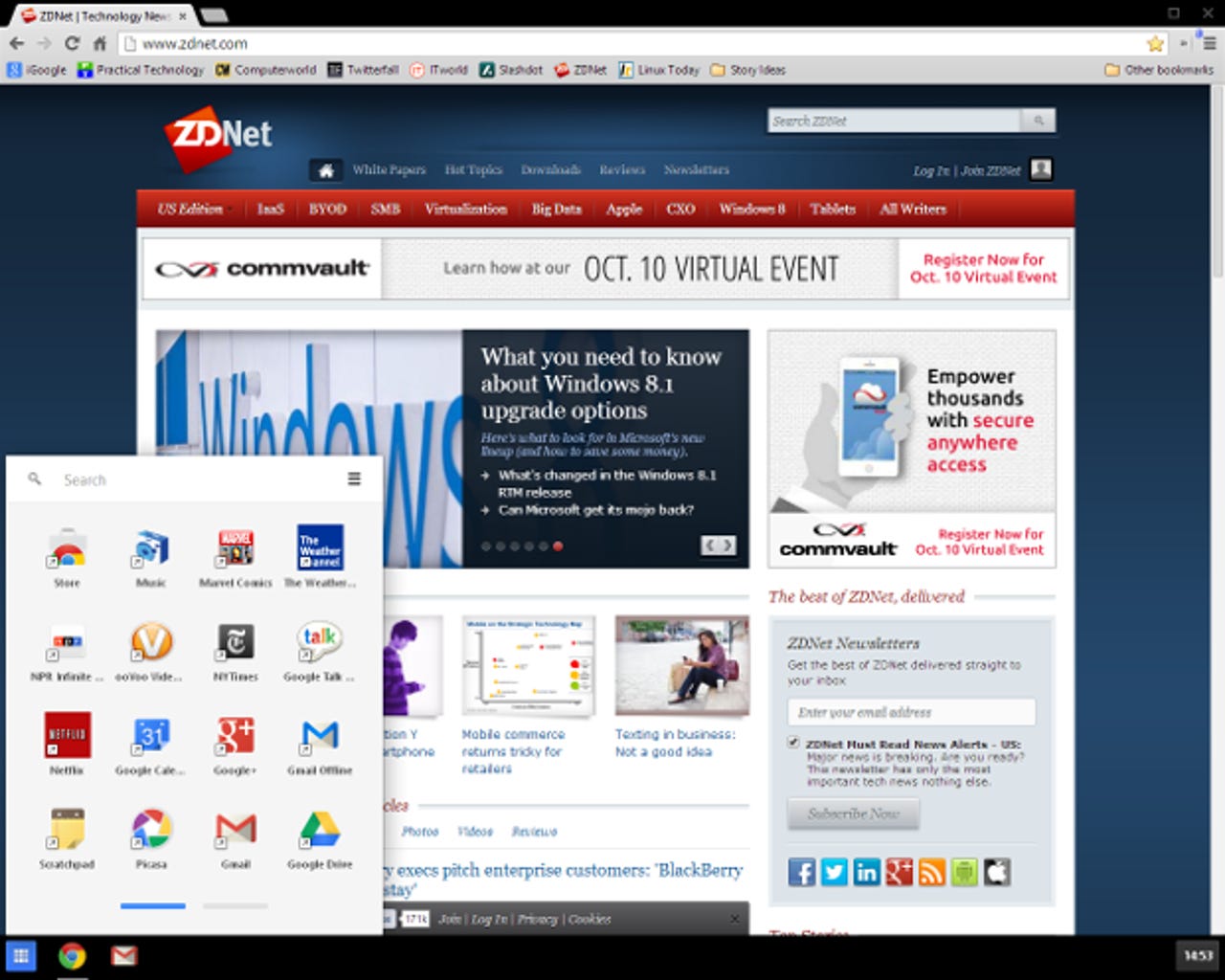A taste of Chrome OS in Windows 8.x

First things first. Google is not sneaking Chrome OS into Windows 8.x. With the right experimental version of the Chrome Web browser and right settings, it may look like it and act like it, but it's not Chrome OS.

What you're really seeing is a beta of the Chrome Web browser, Chrome 32, running on Windows 8.x. The coming together of two technical paths, one by Microsoft and other by Google, enables the Windows developer channel build of the Chrome Web browser to masquerade as Chrome OS.
Microsoft's new mission statement
On the Microsoft side, ever since Windows 8, Microsoft has been working on an immersive, plug-in-free Web browser experience that could only be used with the Modern user interface, aka Metro. The first of these was Internet 10 in Metro mode.
With this approach, as the Microsoft document, "Developing a new experience enabled desktop browser" (DOCX document), states: "A desktop browser that participates in the new experience when the user wants the browser to do so. Such a browser can provide HTML5 rendering for Web pages and service HTTP/HTTPS requests. By definition, such a browser has full access to Win32 APIs for rendering HTML5, including the ability to use multiple background processes, JIT [just-in-time] compiling, and other distinctly browser-related functionality (like background downloading of files). Desktop browsers typically run at medium or low integrity level."
In other words, a properly written browser for Metro has far more access to the underlying operating system than Web browsers usually do.
At the same time, Google, has been giving both Chrome OS and the Chrome Web browser "Chrome Packaged Apps." These are HTML5, JavaScript and Cascading Style Sheets (CSS) apps that run directly on the browser. Chromebook users know these well.
Featured
What you get when you combine the two developments in the latest dev channel build of Chrome is a Metro version of the Chrome Web browser that looks and acts a lot like Chrome OS. You can still run the normal Chrome Web browser by launching it from the desktop interface.
If you want to give it a try, here's how you do it. First download the developer build for Chrome 32. Then, install it in Windows 8 or 8.1. Next, make Chrome the default Windows 8 browser. To do this, first open Chrome, go to settings, and in the "Default browser" section, click Make Google Chrome my default browser. Next, click on the Chrome tile from the Windows 8 Metro Start screen. If you start it from any other place, such as the desktop, you'll be running the "ordinary" version of Chrome. You should then see a screen like the one above.
Google announced that it was going to bring its Chrome apps first to Windows and then the Mac and Linux in early September. This is the first step to keeping that promise.
According to Erik Kay, Google Engineering Director and self-proclaimed Chrome App-ologist, when fully realized these Chrome-based apps will bring the following features to Windows and then other operating systems:
Work off-line: Keep working or playing, even when you don’t have an Internet connection.
Connect to the cloud: Access and save the documents, photos and videos on your hard drive as well as on Google Drive and other web services.
Stay up-to-speed: With desktop notifications, you can get reminders, updates and even take action, right from the notification center.
Play nice with your connected devices: Interact with your USB, Bluetooth and other devices connected to your desktop, including digital cameras.
Keep updated automatically: Apps update silently, so you always get all the latest features and security fixes (unless permissions change).
Pick up where you left off: Chrome syncs your apps to any desktop device you sign in to, so you can keep working.
Sleep easier: Chrome apps take advantage of Chrome’s built-in security features such as Sandboxing. They also auto-update to make sure you have all the latest security fixes. No extra software (or worrying) required.
Launch apps directly from your desktop: To make it quicker and easier to get to your favorite apps, we’re also introducing the Chrome App Launcher for Windows, which will appear when you install your first new Chrome App. It lives in your taskbar and launches your apps into their own windows, outside of Chrome, just like your desktop apps.
That's a lot of promises but this version isn't ready to keep them yet. Chrome 32, as you would expect from a developer's version, is buggy. While it never crashed on me on Windows 8.1, it was very quirky at times.
If you're comfortable with beta software, and you want to see how Google sees the future of personal computing and the Web without buying a Chromebook or running Chrome OS in a virtual machine, give this a try.
Will Google eventually make this the default for Chrome on Windows? We don't know yet. A Google representative told me, "We're always experimenting with new features in Chrome, especially in the Dev channel, but have nothing to announce at this time."
Related Stories: